Coat - 1874 dark blue 5 - button blouse. Alternatives: 1872 pleasted blouse, ACW sack coat or occasional, outdated shell jacket. Yellow piping on collar and cuffs, brass buttons.
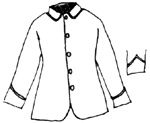 1874 Blouse
1874 Blouse
Rank Chevrons - in branch colour (yellow for cavalry) worn point down, above elbow. Never worn on shirt. 2 stripes for corporal; 3 stripes for sergent.
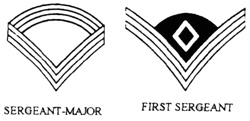
Trousers - llight to mid-blue, often reinforced inside legs and uder seat with canvas panels (white or brown). Troops south of Washington allowed to wear white trousers. Officers and NCOs (not troopers), had yellow stripes down outer seams - 1/2" for corporals, 1" for sergeants and 1 1/2" for officers.
Shirts - officially the 1874 grey flannel shirt with small, rllover collar. In 1875 some dark blue shirts were issued on a trial basis. Often privately purchased striped, check or fireman's shirts were worn. Stripes were usually fine red, blue or black on white background. Simple checks. Fireman's shirts could be blue, grey or red, often with contrasting trim. In my own wargames regiment about half those wearing shirts have the grey official issue with the remainder wearing a mixture of non-regulation styles, except for one company in distinctive dark blue shirts.
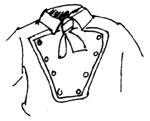
A FIREMAN'S shirt with contrasting trim
Neckerchiefs - not officially issued. Could be any colour, but red more likely than Hollywood yellow. Photos often show spotted scarves.
Hats - officially the 1872 folding campaign hat. Made in black felt, its brim could be fastened up and the hat worn as a bicorne. Could have yellow cords and tassels. Most cavalrymen probably wore privately acquired hats - straw or black, white, grey or brown civilian types.
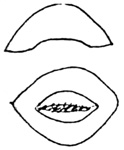
1872 Model - showing distinctive shape of brim
Boots - black with brass spurs
Equipment - carbine sling and holster black. Buckle etc. on sling brass. Some individuals or whole companies dispensed with the carbine sling and held their carbines in a loop on the pommel of their saddles. Belts with cartridge loops were not official issue and were usually made by adding leather or canvas (brown, grey, or blue) loops to a black leather belf. Belt buckle brass.
Campaign Dress - at this time generally scruffy with many non-regulation items. In summer troops often rolled and stowed their blouses and fought in shirtsleeves.
Officers - on campaign officers dressed informally in a mixture of military and civilian items. Coats could be fringed buckskin, plain or black braided blouses. Yellow shoulder straps should have been worn on uniform coats, but were often omitted. Trousers could be the regulation sky blue with yellow stripes, buckskin, white canvas or civilian style. Hats were as varied as those of the enlisted men, although probably of better quality.
Occasionally tropical helmets were worn. Sometimes brown or naturally coloured canvas leggings were worn rather than high boots. Many of Custer's officers at Little Bighorn wore blue firemans shirts with wide floppy collars with crossed sabres in white or yellow silk embroidered on their points.
Horse Equipment - saddlery black leather with blue linen girth. Bridle black leather with steel bit. Dark blue saddle blanket with orange stripe. Sky blue overcoat rolled on pommel. Grey forage sack on cantle. Black leather saddlebags. Plain tim cup. Canteen in brownish grey or sky blue cover with off-white sling. Pale brown linen nosebag with black leather trim carried in front of right leg.
Horses - horses were often distributed to individual companies according to the colour.
For example - shortly after the formation of the 7th Cavalry, Custer had the twelve companies' horses divided and matched by color: Company A - BLACK, Company B - BAYS, Company C - LIGHT SORRELS, Company D - BAYS, Company E - GREYS (includes white horses), Company F - BAYS, Company G - SORRELS, Company H - BLOOD BAYS, Company I - BAYS, Company K - SORRELS, Company L - BAYS and Company M - Mixed.
Bays are brown with black maines, tail and limbs. Sorrels are known as Chestnuts in England and have manes, tails and limbs of the same colour as their bodies.
Note that there is no J Company. Thisis to avoid any possible confusion with handwritten "I" or "F".
Trumpeters rode greys
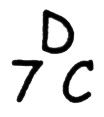
Brand of D company seventh cavalry
Flags - a cavalry regiment had 13 flags: one regimental standard and 12 company guidons. Custer also had a personal standard carried by a sergeant, who rode close behind him. The lance was 9 feet long with a brass spearhead and ferrule.
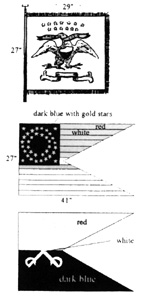
Regimental Standard - blue, yellow fringe with painted arms of the United States. Name of regiment (eg SEVENTH CAVALRY) on scroll.
Back to MWAN #89 Table of Contents
Back to MWAN List of Issues
Back to MagWeb Magazine List
© Copyright 1997 Hal Thinglum
This article appears in MagWeb (Magazine Web) on the Internet World Wide Web.
Other military history articles and gaming articles are available at http://www.magweb.com